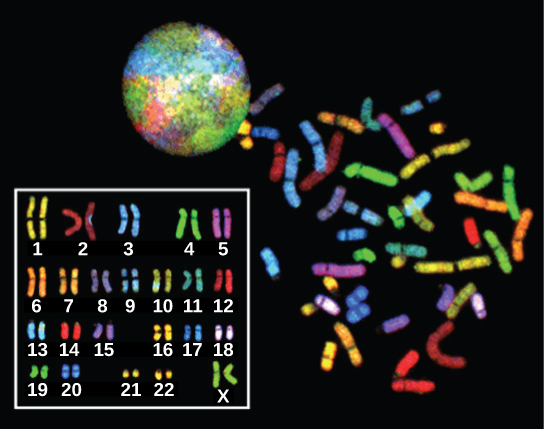What Is The Genetic Makeup Of A Human Reproductive Cell
Chapter 6: Introduction to Reproduction at the Cellular Level
six.i The Genome
Learning Objectives
By the stop of this section, y'all will be able to:
- Describe the prokaryotic and eukaryotic genome
- Distinguish between chromosomes, genes, and traits
The continuity of life from 1 cell to another has its foundation in the reproduction of cells by way of the cell cycle. The prison cell cycle is an orderly sequence of events in the life of a cell from the sectionalization of a unmarried parent cell to produce ii new girl cells, to the subsequent division of those daughter cells. The mechanisms involved in the cell cycle are highly conserved across eukaryotes. Organisms as various equally protists, plants, and animals employ similar steps.
Genomic DNA
Before discussing the steps a cell undertakes to replicate, a deeper agreement of the structure and role of a jail cell's genetic information is necessary. A prison cell's consummate complement of Dna is called its genome. In prokaryotes, the genome is composed of a single, double-stranded DNA molecule in the class of a loop or circle. The region in the cell containing this genetic material is called a nucleoid. Some prokaryotes likewise have smaller loops of Deoxyribonucleic acid called plasmids that are non essential for normal growth.
In eukaryotes, the genome comprises several double-stranded, linear DNA molecules (Figure 6.two) bound with proteins to form complexes chosen chromosomes. Each species of eukaryote has a characteristic number of chromosomes in the nuclei of its cells. Human torso cells (somatic cells) take 46 chromosomes. A somatic cell contains 2 matched sets of chromosomes, a configuration known as diploid. The letter n is used to represent a single set of chromosomes; therefore a diploid organism is designated 2due north . Human being cells that contain one set of 23 chromosomes are called gametes, or sex cells; these eggs and sperm are designated n, or haploid.

The matched pairs of chromosomes in a diploid organism are called homologous chromosomes. Homologous chromosomes are the same length and have specific nucleotide segments called genes in exactly the same location, or locus. Genes, the functional units of chromosomes, decide specific characteristics by coding for specific proteins. Traits are the different forms of a characteristic. For example, the shape of earlobes is a characteristic with traits of free or fastened.
Each copy of the homologous pair of chromosomes originates from a different parent; therefore, the copies of each of the genes themselves may non exist identical. The variation of individuals within a species is caused past the specific combination of the genes inherited from both parents. For example, there are 3 possible gene sequences on the human chromosome that codes for blood blazon: sequence A, sequence B, and sequence O. Because all diploid human cells have two copies of the chromosome that determines blood type, the claret type (the trait) is determined past which two versions of the marker gene are inherited. It is possible to accept two copies of the same gene sequence, one on each homologous chromosome (for case, AA, BB, or OO), or two different sequences, such as AB.
Modest variations in traits such equally those for blood type, center color, and top contribute to the natural variation plant within a species. The sex chromosomes, X and Y, are the single exception to the dominion of homologous chromosomes; other than a small amount of homology that is necessary to reliably produce gametes, the genes found on the X and Y chromosomes are non the aforementioned.
Section Summary
Prokaryotes accept a single loop chromosome, whereas eukaryotes have multiple, linear chromosomes surrounded by a nuclear membrane. Man somatic cells accept 46 chromosomes consisting of ii sets of 22 homologous chromosomes and a pair of nonhomologous sex activity chromosomes. This is the iinorth, or diploid, state. Human gametes accept 23 chromosomes or one complete set of chromosomes. This is the due north, or haploid, state. Genes are segments of Deoxyribonucleic acid that code for a specific protein or RNA molecule. An organism's traits are determined in large part by the genes inherited from each parent, but too by the environs that they experience. Genes are expressed as characteristics of the organism and each feature may have different variants called traits that are caused by differences in the Deoxyribonucleic acid sequence for a gene.
Glossary
diploid: describes a cell, nucleus, or organism containing two sets of chromosomes (2n)
gamete: a haploid reproductive jail cell or sex cell (sperm or egg)
gene: the physical and functional unit of measurement of heredity; a sequence of Dna that codes for a specific peptide or RNA molecule
genome: the entire genetic complement (Deoxyribonucleic acid) of an organism
haploid: describes a jail cell, nucleus, or organism containing one set of chromosomes (northward)
homologous chromosomes: chromosomes of the same length with genes in the aforementioned location; diploid organisms take pairs of homologous chromosomes, and the members of each pair come from different parents
locus: the position of a gene on a chromosome
Source: https://opentextbc.ca/biology/chapter/6-1-the-genome/
Posted by: jacksonreate1987.blogspot.com

0 Response to "What Is The Genetic Makeup Of A Human Reproductive Cell"
Post a Comment